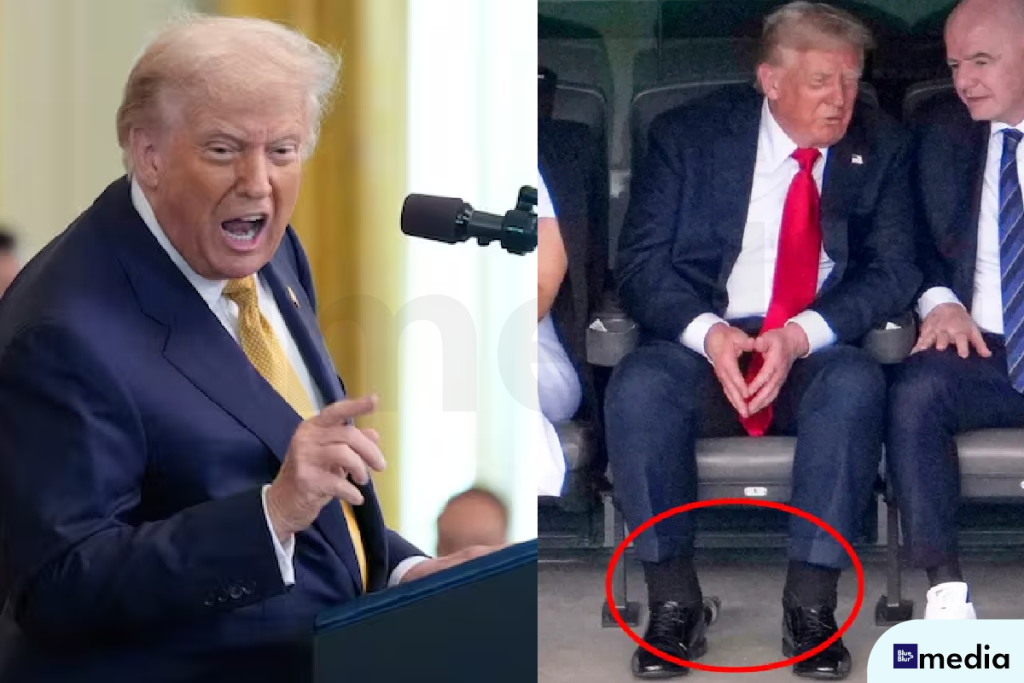Trump diagnosed with chronic venous insufficiency following leg swelling

The White House announced Thursday that President Donald Trump has received a diagnosis of chronic venous insufficiency following widespread speculation about visible bruises on the president’s hands in recent photographs. Medical officials disclosed this information after conducting comprehensive examinations to address public concerns about the 79-year-old president’s health, which has become a focal point given Trump diagnosed condition.
White House Press Secretary Karoline Leavitt revealed that Trump underwent extensive medical evaluations, including specialized blood vessel tests, after he experienced noticeable swelling in his feet and lower legs. This was part of ongoing evaluations of Trump’s health condition. The president underwent a comprehensive medical exam after experiencing swelling in his lower legs in recent weeks. Medical professionals conducted thorough vascular assessments to determine the underlying cause of these symptoms.
Leavitt explained that Trump’s visible hand bruising resulted from tissue damage caused by frequent handshakes while the president takes aspirin as part of his cardiovascular health regimen. She characterized this condition as a normal aspect of cardiovascular dysfunction management, emphasizing that the bruising represents a common side effect rather than a serious medical concern. Trump’s health condition has been under scrutiny in this context.
Trump has consistently promoted his excellent health throughout his political career, famously declaring himself “the healthiest president who ever lived.” At 79 years old, he continues to maintain active public schedules and engagements, though recent medical findings provide new insights into age-related health challenges. However, the recent diagnosis of chronic venous insufficiency has prompted a closer look at Trump’s health condition.
The president diagnosed with a minor vein condition known as chronic venous insufficiency that prevents leg veins from efficiently pumping blood back to the heart. This condition causes blood to accumulate in the lower extremities, resulting in swelling and discomfort in the limbs.
Dr. Merrill Logan, an assistant professor of vascular surgery at the University of Texas at Austin, explained that healthy veins and valves actively push blood upward from the legs back toward the heart. The circulatory system faces particular challenges in the lower extremities because blood must flow against gravitational forces.
“Chronic venous insufficiency occurs when blood flows backward through the legs because those veins and valves stop working properly,” Dr. Logan clarified. This malfunction disrupts normal circulation patterns and creates the pooling effect that leads to visible swelling and discomfort.
Trump made history by becoming the oldest president ever sworn into office when he began his second term in January at 78 years and seven months old. This age milestone places him in a demographic where chronic venous insufficiency commonly occurs.
Press Secretary Leavitt emphasized that medical examinations revealed “no evidence of venous occlusion or arterial disease” and confirmed that all diagnostic test results fell “within normal limits.” These findings provide reassurance about the president’s overall cardiovascular health status amid discussions of Trump’s health condition.
White House physician Dr. Sean Barbabella issued a statement to reporters describing the president’s condition as “non-serious and common,” particularly among individuals over 70 years of age. This medical assessment contextualizes Trump’s diagnosis within normal age-related health expectations.
Dr. Barbabella’s medical note confirmed that additional testing showed Trump exhibited “no signs of heart disease, kidney problems, or systemic disease,” supporting earlier statements from Press Secretary Leavitt. These comprehensive results address broader health concerns beyond the vascular condition.
The White House physician concluded that Trump maintains “excellent health” despite the chronic venous insufficiency diagnosis. This overall positive assessment aims to address public concerns while acknowledging the specific vascular condition.
Photographers captured images showing apparent leg swelling during Trump’s attendance at the FIFA Club World Cup final in New Jersey on July 13. These public appearance photos contributed to growing speculation about the president’s health status.
Additional photographs revealed hand discoloration during Trump’s White House meeting with Bahraini Prime Minister Salman bin Hamad bin Isa Al Khalifa earlier this week. These images provided further evidence of the bruising that medical officials later attributed to aspirin therapy and frequent handshakes.
A similar bruise-like mark appeared on the president’s hand during his February meeting with French President Emmanuel Macron. This earlier incident suggests the condition has been ongoing, though medical disclosure only occurred recently.
The combination of swollen legs and visible bruising generated widespread speculation and rumors across internet platforms, with many suggesting the president suffered from an undisclosed serious illness. The White House medical announcement aimed to address these concerns with factual medical information about Trump’s health condition.
Following Trump’s annual physical examination in April, Dr. Barbabella previously reported that the president “displays good health.” This earlier assessment preceded the recent chronic venous insufficiency diagnosis and comprehensive vascular testing.


